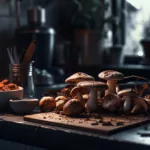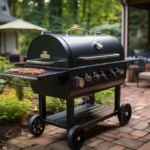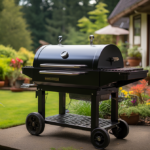Table of Contents
Unlocking the Secrets Guide to Mastering Pasta Cooking to Perfection: A Foolproof Guide for Pasta Enthusiasts
Hey there pasta lovers! Are you tired of ending up with overcooked, mushy noodles or undercooked, tough pasta? Well, fret no more because we’ve got the ultimate guide to help you achieve perfect pasta every single time!
Whether you’re a culinary newbie or a seasoned home cook, cooking pasta to perfection can sometimes be a challenging feat. But fear not, because this comprehensive step-by-step guide is here to take your pasta-cooking skills to the next level.
In this blog post, we’ll dive deep into the world of pasta, exploring different types of pasta shapes and their ideal cooking methods. From classic spaghetti to trendy tortellini, we’ve got you covered.
But it’s not just about the pasta itself; we’ll also reveal the secrets to creating the most flavorful and delicious pasta sauces. From rich and creamy Alfredo to tangy and zesty Marinara, we’ll walk you through each sauce step-by-step, ensuring that your pasta is always bursting with amazing flavors.
No guide would be complete without tackling common pasta cooking mistakes and offering foolproof tips and tricks. We’ll address the notorious clumping issue, the proper way to salt the water, and the ideal cooking times for different pasta types.
So, get ready to dive into the world of pasta perfection. Dust off your apron, grab your favorite pasta pot, and let’s embark on this culinary journey together. Perfect pasta awaits, and you’re just a few steps away from becoming a pasta-cooking pro!
Types of Pasta: Exploring Different Shapes and Sizes
Pasta comes in a myriad of shapes and sizes, each with its own unique characteristics and ideal cooking methods. Understanding the different types of pasta can help you choose the perfect shape to complement your sauce and enhance the overall dining experience. Let’s dive into the wonderful world of pasta shapes!
1. Spaghetti: The most classic and versatile pasta shape, spaghetti is long, thin, and cylindrical. It pairs well with various sauces and is great for dishes like spaghetti carbonara or aglio e olio.
2. Penne: With its tubular shape and angled edges, penne is perfect for holding onto thick and chunky sauces. It works wonders in baked pasta dishes like penne alla vodka or baked penne with sausage.
3. Fettuccine: This wide and flat ribbon-like pasta is often associated with rich and creamy sauces. It pairs perfectly with Alfredo sauce and is commonly used in dishes like fettuccine Alfredo with chicken.
4. Farfalle: Also known as bow tie pasta, farfalle adds a touch of whimsy to any pasta dish. The unique butterfly shape catches sauces well and works great in pasta salads or dishes like farfalle with sun-dried tomatoes and spinach.
5. Rigatoni: This large, cylindrical pasta features ridges along its surface, making it perfect for capturing thicker sauces. It’s ideal for dishes like baked rigatoni with meatballs or creamy tomato rigatoni.
6. Tortellini: These little stuffed pasta pockets are a delightful treat. Filled with cheese, meat, or even veggies, tortellini adds a burst of flavor to soups, salads, or simply served with a light butter sauce.
7. Lasagna: While not technically a pasta shape, lasagna noodles are wide and flat, perfect for layering in lasagna casseroles. Whether you go for classic meat lasagna or a vegetarian version, this pasta will surely impress.
Each pasta shape has its own cooking time, so be sure to follow the instructions on the package and test for the desired level of al dente texture. Experiment with different shapes to find your favorites and get creative with new recipes!
Remember, pasta cooking is all about having fun and trying new things. So, let your culinary creativity run wild, and enjoy the wonderful world of pasta shapes and sizes!
No products found.
The Science Behind Perfect Pasta: Understanding Cooking Times and Water Ratio
Cooking pasta may seem like a simple task, but there’s actually a bit of science involved in achieving that perfectly cooked pasta. Understanding the cooking times and water ratio can make a significant difference in the texture and taste of your pasta. Let’s dive into the science behind it!
1. Cooking Times: Different pasta shapes and sizes have varying cooking times. It’s crucial to follow the instructions on the package for the recommended cooking time. However, keep in mind that those times are just a guideline. Testing the pasta for the desired texture is essential. Cook it al dente, which means it’s firm to the bite but not overly soft or mushy. Remember that pasta will continue to cook a bit even after you’ve drained it, so it’s better to slightly undercook it during boiling.
2. Water Ratio: The amount of water you use to cook your pasta plays a crucial role in the cooking process. Follow the general rule of thumb: for every 4 ounces (113 grams) of pasta, use 1 quart (4 cups) of water. Using enough water ensures that pasta has enough room to move around and prevents it from sticking together. Adding salt to the water is also essential for enhancing the pasta’s flavor. Aim for about 1-2 tablespoons of salt per gallon of water.
3. Boiling Technique: To achieve perfectly cooked pasta, maintain a rolling boil throughout the cooking process. Stir the pasta initially to prevent it from sticking to the bottom of the pot. Once the pasta is submerged and the water is boiling again, reduce the heat slightly. Stir occasionally to ensure even cooking and prevent clumping. Avoid adding oil to the water, as it can coat the pasta and prevent the sauce from adhering to it.
By understanding the cooking times, using the right water ratio, and employing the proper boiling technique, you can master the art of cooking pasta to perfection. So, grab your favorite pasta, get your water boiling, and let the science work its magic to deliver the most delicious and satisfying pasta dishes you’ve ever tasted!
Step 1: Choosing the Right Pasta for Your Dish
When it comes to cooking pasta to perfection, the first step is selecting the right type of pasta for your dish. With a wide array of pasta shapes and sizes available, knowing which one to choose can make a significant difference in your culinary adventure. Here’s how to make the perfect pasta match:
1. Consider the Sauce: The sauce you plan to use with your pasta should be your guiding factor when selecting the shape. Thicker, chunkier sauces pair well with pasta shapes that can hold the sauce, like Penne or Rigatoni. For lighter, oil-based sauces, consider using long and thin pasta varieties like Spaghetti or Linguine.
2. Texture Matters: Different pasta shapes result in different textures when cooked. If you prefer a softer bite, go for pasta shapes that are thicker or have more surface area, such as Farfalle or Fusilli. If you prefer a more delicate and silky texture, opt for pasta shapes like Angel Hair or Capellini.
3. Consider Cooking Time: Each pasta shape has its own cooking time, and it’s important to consider this when choosing the right pasta for your dish. If you’re limited on time, select quick-cooking pasta varieties like Orzo or Shells. If you have more time on your hands and want to indulge in a longer cooking process, try varieties like Lasagna or Ravioli.
4. Experiment and Have Fun: Don’t be afraid to step out of your comfort zone and try new pasta shapes! There’s a whole world of exciting options waiting to be discovered. From unique shapes like Radiatori or Cavatelli to traditional favorites like Fusilli or Penne, the possibilities are endless. Experiment with different shapes and have fun exploring new culinary horizons.
By carefully selecting the right pasta shape based on the sauce, desired texture, cooking time, and personal preferences, you’re setting the foundation for creating a mouthwatering pasta dish. So, grab your apron, head to the pasta aisle, and embark on a pasta journey that will leave your taste buds dancing with delight!
Step 2: Cooking Pasta to Al Dente: The Perfect Texture
One of the secrets to achieving perfect pasta is cooking it to “al dente,” which means the pasta is cooked until it is firm to the bite while still maintaining a slight resistance. This ideal texture ensures that your pasta is not overcooked and mushy nor undercooked and tough. Follow these steps to achieve pasta perfection:
1. Read the Package Instructions: Each type of pasta has a different cooking time, so it’s crucial to read the package instructions for the recommended cooking time. This will give you a general idea of how long the pasta needs to cook.
2. Salt the Water: Before adding the pasta, bring a large pot of water to a rolling boil. Once the water is boiling, add salt to enhance the pasta’s flavor. Aim for around 1-2 tablespoons of salt per gallon of water. Remember, pasta absorbs salt during cooking, so don’t be afraid to add enough salt to the water.
3. Test for Al Dente: Begin testing the pasta for doneness a minute or two before the recommended cooking time. Fish out a single strand or piece of pasta, let it cool slightly, and take a bite. The pasta should be firm to the bite with a slight resistance, indicating that it is al dente. Avoid overcooking, as the pasta will continue to cook slightly even after draining.
4. Reserve Some Pasta Water: Before draining the cooked pasta, remember to reserve a cup of the starchy pasta water. This water can be used to adjust the consistency of your sauce if needed. The starchy water helps bind the sauce with the pasta, creating a more cohesive and flavorful dish.
Cooking pasta to achieve the perfect al dente texture may take a bit of practice, but once you master it, the results will be worth it. With a little bit of patience and a discerning palate, you’ll be delighting in pasta that’s perfectly cooked every time. So, get your pot boiling, and prepare for a pasta experience like no other!
Step 3: Salting the Water: How Much is Too Much?
Adding salt to the pasta cooking water is an essential step that can elevate the flavor of your pasta dishes. However, there’s often confusion about how much salt is too much or too little. Follow these guidelines to achieve the perfect balance:
1. Use Enough Salt: It’s crucial to add enough salt to the water when cooking pasta. The salt enhances the pasta’s natural flavor, making it more enjoyable to eat. As a general rule of thumb, aim for about 1-2 tablespoons of salt per gallon of water. Don’t worry; the majority of the salt remains in the water and is not absorbed by the pasta.
2. Avoid Oversalting: While salt is necessary, it’s essential not to go overboard. Adding excessive amounts of salt can result in an overly salty pasta dish that’s difficult to enjoy. Start with a moderate amount of salt, and if needed, you can always adjust the seasoning in your sauce later.
3. Consider Personal Taste: Everyone’s taste buds are different, and what may be perfectly seasoned for one person may be too salty or not salty enough for another. Take into account your personal preference when it comes to salt. If you prefer a milder taste, use a bit less salt. Conversely, if you enjoy a bolder flavor, you can add a touch more.
4. Taste as You Go: The best way to gauge if your pasta water is salted to your liking is to taste it. Dip a spoon into the boiling water (be careful!) and taste a small amount. If the water tastes seasoned but not overly salty, you’re on the right track.
Finding the perfect balance of salt in your pasta water may take a bit of trial and error. Remember that it’s always better to start with less salt and adjust as needed. With practice, you’ll develop a sense of how much salt to use to achieve the ideal flavor for your pasta dishes. So, go ahead, season that water, and get ready to indulge in flavorful pasta creations!
Step 4: Avoiding Pasta Clumps: Techniques for Proper Stirring
We’ve all experienced the frustration of finding our beloved pasta stuck together in clumps. To avoid this pasta tragedy and ensure each strand remains perfectly separate, follow these techniques for proper stirring:
1. Use a Large Pot: Using a pot that’s big enough for the amount of pasta you’re cooking is crucial. Pasta needs space to move around while boiling to prevent it from sticking together. A larger pot also means more water, reducing the chances of overcrowding and clumping.
2. Stir Immediately: Once you add the pasta to the boiling water, give it a quick stir immediately. This initial stir helps prevent the pasta from sticking to the bottom of the pot or clumping together.
3. Stir Occasionally: While the pasta cooks, stir it occasionally to encourage movement and discourage sticking. Use a wooden spoon or a pasta fork to gently separate any strands that may be sticking together.
4. Mind the Boil: Be mindful of the boiling process and adjust the heat if necessary. Too vigorous of a boil can cause the pasta to bounce around and potentially stick together. Keep a steady, gentle boil throughout the cooking process.
5. Add Salt and Oil Carefully: When adding salt and oil to your pasta water, do so in a balanced manner. Salt helps enhance the flavor and prevent the pasta from being bland, but adding too much can make the water excessively salty. Similarly, adding oil can create a slippery coating on the pasta, hindering sauce adherence.
By following these stirring techniques, you can prevent pasta clumps and ensure each strand is cooked to perfection. Remember, a little attention and occasional stirring can go a long way in achieving gorgeously separated pasta. So, get your pot and wooden spoon ready, and say goodbye to pasta clumps forever!
Step 5: Making Homemade Pasta Sauce: From Classic to Creative
A great pasta dish goes hand in hand with a delicious homemade sauce. While store-bought sauces are convenient, there’s something special about creating your own. From classic marinara to creative, flavorsome concoctions, here’s how to make homemade pasta sauce:
1. Classic Marinara: A staple in Italian cuisine, marinara sauce is simple yet bursting with flavor. Sauté garlic and onions in olive oil until fragrant. Add crushed tomatoes and simmer with herbs like basil, oregano, and a pinch of red pepper flakes. Let it cook down to develop rich flavors. Season with salt and pepper to taste.
2. Creamy Alfredo: Indulge in a luscious creamy Alfredo sauce by melting butter in a saucepan and adding minced garlic. Stir in heavy cream, grated Parmesan cheese, and a pinch of nutmeg. Cook until the sauce thickens, then season with salt and pepper. Toss with your favorite pasta for a decadent delight.
3. Pesto Perfection: For a vibrant and fresh sauce, make your own pesto. Blend together fresh basil leaves, pine nuts, garlic, Parmesan cheese, and olive oil until smooth. Adjust the consistency by adding more oil if needed. Toss with your cooked pasta, and you’ll be transported to a basil-infused paradise.
4. Arrabbiata Heat: Take your taste buds on a fiery adventure with arrabbiata sauce. Sauté crushed red pepper flakes and garlic in olive oil. Add diced tomatoes, tomato paste, and a splash of red wine. Simmer until the sauce thickens, then season with salt and pepper. This spicy delight pairs perfectly with penne or rigatoni.
5. Bold and Creative: Don’t be afraid to get creative and experiment with your own sauce creations. Add sautéed vegetables, like mushrooms or bell peppers, for extra depth. Incorporate cooked ground meat for a heartier sauce. Roast cherry tomatoes for a burst of sweetness. Let your imagination run wild!
Making your own homemade pasta sauce allows you to customize flavors to your liking. From classic favorites to innovative twists, the possibilities are endless. So, grab your ingredients, unleash your culinary creativity, and elevate your pasta dishes with a personal touch. Homemade pasta sauce will take your meal to the next level of deliciousness!
Step 6: Pairing the Perfect Sauce with the Perfect Pasta Shape
Choosing the right pasta shape is important, but pairing it with the perfect sauce is what truly elevates your pasta dish to a whole new level. The right combination ensures that the flavors harmonize and create a delightful culinary experience. Here are some fantastic pasta and sauce pairings to excite your taste buds:
1. Spaghetti with Bolognese: Classic spaghetti pairs beautifully with rich and savory Bolognese sauce. The long, thin strands of spaghetti elegantly embrace the meaty sauce, ensuring every bite is a burst of flavor.
2. Penne with Vodka Sauce: The tube-like shape of penne captures the creamy vodka sauce, allowing each bite to be filled with its lusciousness. The slight ridges on penne also help hold the sauce, creating a delectable combination.
3. Linguine with Clam Sauce: Linguine’s flat and slender shape is perfect for clinging on to the delicate flavors of clam sauce. The linguine strands intertwine with the briny sauce, creating a delicious symphony of flavors.
4. Farfalle with Pesto: The bow-tie shape of farfalle captures the vibrant and herbaceous pesto sauce. The nooks and crannies of the pasta hold the sauce beautifully, ensuring a burst of flavor in every bite.
5. Rigatoni with Creamy Tomato Sauce: Rigatoni, with its large and hollow shape, is ideal for capturing the creamy and chunky tomato sauce. Each rigatoni piece becomes a little vessel of deliciousness, making for a satisfying and flavorful pasta dish.
6. Lasagna with Bechamel Sauce: Lasagna sheets are layered with a rich bechamel sauce, meaty ragu, and cheese for a comforting and indulgent dish. The wide and flat noodles provide a solid foundation for the layers of flavors.
Experiment and explore different sauce and pasta shapes to find your own perfect combinations. The world of pasta is filled with infinite possibilities, allowing you to create unique and extraordinary dishes with your favorite flavors. So, get creative, unleash your inner chef, and enjoy the enchanting dance between pasta and sauce in every bite!
Step 7: Tasting and Adjusting: The Finishing Touch for Flawless Flavor
The final step to achieving perfect pasta is all about tasting and adjusting the flavors to your liking. This is where you have the opportunity to add the finishing touch and ensure that every bite is bursting with deliciousness. Here’s how to master the art of tasting and adjusting:
1. Taste the Pasta: Once your pasta is cooked to al dente perfection, don’t be afraid to sample a strand or two to ensure it has the desired texture. Remember, al dente means the pasta should be firm to the bite with a slight resistance.
2. Taste the Sauce: Dip a spoon into your sauce and savor the flavors. Is it well-balanced, or does it need a little tweaking? Pay attention to the saltiness, sweetness, acidity, and overall richness of the sauce.
3. Adjust the Seasonings: Based on your taste test, you can adjust the seasonings to achieve the perfect balance. Add a pinch more salt, a sprinkle of pepper, a splash of lemon juice, or a drizzle of honey to enhance the flavors and make them sing.
4. Add the Pasta Water: Remember the reserved pasta water from Step 3? This starchy water can be used to adjust the consistency of your sauce. If your sauce seems too thick, gradually add small amounts of pasta water to loosen it up. Stir and observe the desired consistency.
5. Explore Flavor Enhancers: Don’t shy away from experimenting with flavor enhancers. Some grated cheese, a dollop of butter, or a splash of cream can add a luxurious touch to your sauce. Fresh herbs like basil, parsley, or cilantro can brighten the flavors even further.
By tasting and adjusting, you have the ability to fine-tune your pasta dish and make it truly exceptional. Trust your palate and play around with flavors until you achieve a result that sings to your taste buds. Finally, serve up your flawlessly flavored pasta, and savor the deliciousness with every bite. Happy cooking!
Common Pasta Cooking Mistakes and How to Fix Them
Even the most experienced cooks can make mistakes when cooking pasta. But fear not! With a few simple tips and tricks, you can fix these common pasta cooking mishaps and still end up with a delicious meal. Here’s how to tackle some of the most frequent pasta blunders:
1. Overcooking: We’ve all been guilty of overcooking pasta at some point, resulting in a mushy and unappealing texture. The fix? Start checking your pasta for doneness a minute or two before the recommended cooking time. Remember, you want your pasta to be al dente, firm to the bite but not overly soft. Keep a close eye on it and immediately drain when it reaches the desired texture.
2. Undercooking: On the flip side, discovering that your pasta is undercooked can be disappointing. The solution is simple: cook it a little longer. Return the undercooked pasta to the boiling water and continue cooking in increments of 30 seconds until it reaches the desired doneness.
3. Sticky Noodles: Sticky pasta is often caused by not using enough water or not stirring it often enough during cooking. To fix this, simply add more water to the pot and give the pasta a good stir. The extra water will help loosen any clumps, and stirring will prevent further sticking.
4. Salty Pasta: Accidentally oversalting the pasta water happens to the best of us. To salvage the dish, consider adding an acid like lemon juice or vinegar to balance out the saltiness. Alternatively, you can dilute the salty pasta by mixing it with unsalted boiled pasta or rinsing it with cold water if it’s not part of a sauce-based dish.
5. Sauce Separation: If your pasta sauce looks separated or oily, it may just need a little love. Try whisking in a small amount of pasta water or adding a touch of butter to emulsify the sauce. This will help bring the components back together and create a smoother, more cohesive texture.
By knowing how to fix common pasta cooking mistakes, you can overcome any culinary mishap and still enjoy a delicious plate of pasta. Remember, practice makes perfect, so don’t be discouraged if you encounter a blunder along the way. Embrace the learning process, and soon you’ll be cooking pasta like a pro!
Expert Tips and Tricks for Elevating Your Pasta Game
Want to take your pasta cooking to the next level? These expert tips and tricks will help you elevate your pasta game and create restaurant-worthy dishes right in your own kitchen. Get ready to become a pasta pro with these handy techniques:
1. Don’t Rinse the Pasta: After draining the cooked pasta, resist the temptation to rinse it with water. This removes the starch that helps the sauce cling to the pasta, resulting in a less flavorful dish. Simply drain the pasta and immediately toss it in your desired sauce to let the flavors meld together.
2. Finish Cooking in the Sauce: For an extra burst of flavor, finish cooking your pasta in the sauce. After draining the pasta, add it directly to the saucepan and let it simmer for a minute or two. This allows the pasta to absorb the flavors of the sauce, resulting in a more cohesive and delicious dish.
3. Save Pasta Water: Remember to save some of the starchy pasta water before draining. This liquid gold can be used to adjust the consistency of your sauce and help it adhere better to the pasta. Add a splash of pasta water as needed to achieve the perfect sauce consistency.
4. Use High-Quality Ingredients: The key to a phenomenal pasta dish lies in using high-quality ingredients. From the pasta itself to the sauce components, opt for the best quality you can afford. Fresh, vibrant herbs, ripe tomatoes, good quality cheeses, and authentic Italian flour for homemade pasta can truly make a difference.
5. Experiment with Flavors: Don’t be afraid to get creative and experiment with different flavors in your pasta dishes. Add a pinch of red pepper flakes for a spicy kick, a sprinkle of freshly grated Parmesan for richness, or a handful of fresh herbs for a burst of freshness. Let your taste buds guide you and have fun with your flavor combinations.
By incorporating these expert tips and tricks into your pasta cooking routine, you’ll achieve extraordinary results that will impress any pasta enthusiast. So, grab your apron, get cooking, and prepare to wow your family and friends with your newfound pasta prowess!
Conclusion
And there you have it, folks! With this comprehensive step-by-step guide, you now have all the tools and knowledge to master pasta cooking like a pro. From choosing the perfect pasta shape to creating delicious homemade sauces, we’ve covered it all.
Remember, cooking perfect pasta is all about understanding the cooking times, water ratio, and salt levels. Pay attention to the texture, taste, and adjust the seasonings to your liking. Don’t be afraid to get creative with sauce pairings and experiment with different flavors.
Whether you’re cooking for a romantic dinner, a family gathering, or simply satisfying your own pasta cravings, you can now confidently cook up a storm in the kitchen. These expert tips and tricks will ensure that your pasta dishes always shine.
So, roll up your sleeves, gather your favorite ingredients, and get that pot of water boiling. Embrace the art of pasta cooking and let your culinary prowess shine through. Perfect pasta awaits, and with this guide, you’re well on your way to becoming a pasta-cooking maestro!
Now go forth and enjoy the fantastic world of pasta, one perfectly cooked noodle at a time. Buon appetito!









